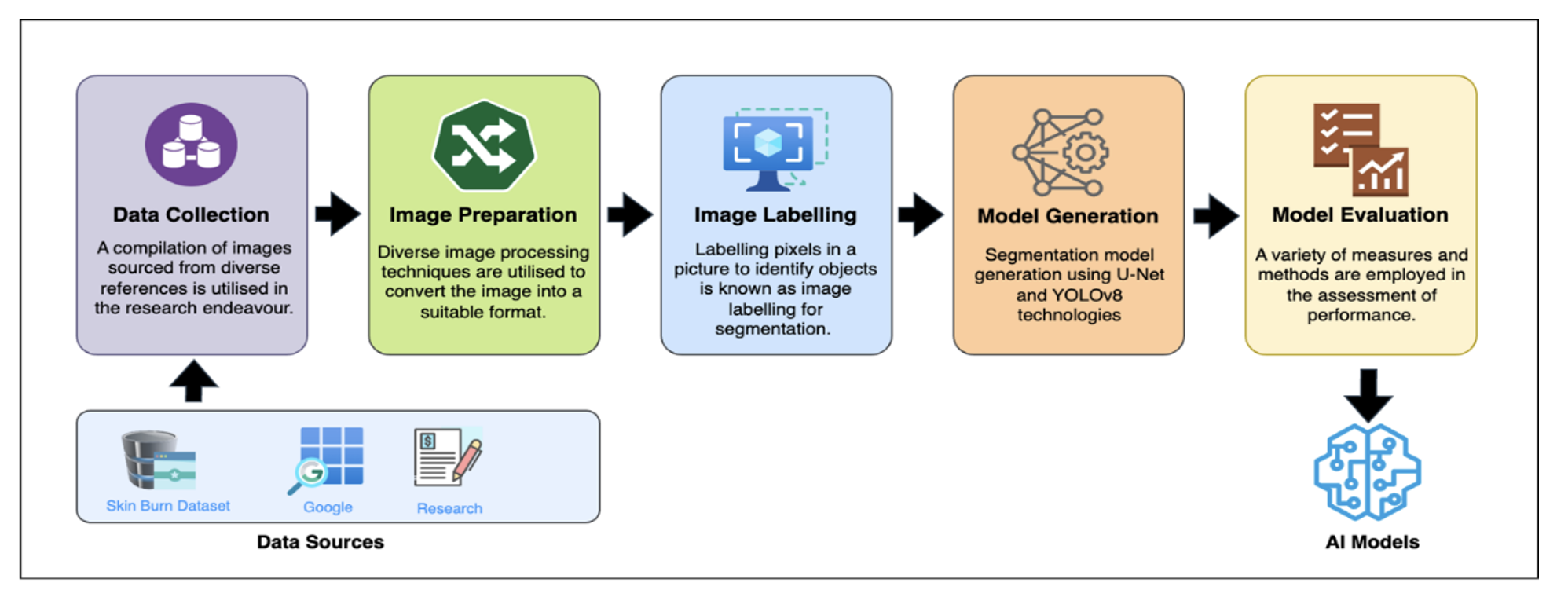การตรวจจับความรุนแรงของแผลไหม้โดยใช้โมเดลการแบ่งส่วน: การเปรียบเทียบระหว่าง U-NET และ YOLOv8
Main Article Content
บทคัดย่อ
การตรวจจับความรุนแรงแผลไหม้ โดยใช้วิธีการทำการตรวจจับพื้นที่ที่สนใจ โดยมีการแบ่งพื้นที่ของแผลไหม้ออกเป็นสามระดับที่แตกต่างกัน: (i) แผลไหม้ระดับที่หนึ่ง (ii) แผลไหม้ระดับที่สอง และ (iii) แผลไหม้ระดับที่สาม ซึ่งแต่ละระดับจะมีลักษะของแผลไหม้แตกต่างกัน เพื่อต้องการตรวจจับความรุนแรงแผลไหม้ จึงมีการนำเทคโนโลยีปัญญาประดิษฐ์ (AI) มาใช้ในการสร้างโมเดลปัญญาประดิษฐ์ นั่นคือโมเดล U-Net และ Yolov8 ซึ่งจะมีชุดข้อมูลภาพที่เป็นภาพแผลไหม้ทั้งหมด 2,000 รูปภาพ และมีรูปภาพแผลไหม้ทั้งสามระดับ เนื่องจากต้องการที่จะเปรียบเทียบประสิทธิภาพระหว่าง U-Net ที่เป็นโมเดลยอดนิยมที่ใช้ในการตรวจจับพื้นที่ที่สนใจ กับ Yolov8 ที่เป็นโมเดลที่พัฒนามาในปี 2023 ซึ่งเป็นโมเดลมาใหม่เมื่อไม่นานมานี้ โดยผลลัพธ์ในการทดลองของ U-Net และ Yolov8 พบว่าผลลัพธ์ที่ดีที่สุดของ U-Net มีค่าความแม่นยำสูงถึง 79.1% และมีค่าสูญเสีย 79.8% ส่วน Yolov8 มีผลลัพธ์ที่ดีที่สุดคือ ค่า mAP 0.5 ดีที่สุดเท่ากับ 0.657 และมีค่าสูญเสียของการแบ่งภาพอยู่ที่ 3.231 และค่าความสูญเสียของการทำนายคลาสอยู่ที่ 1.961 ซึ่งเป็นผลลัพธ์ที่ดีที่สุดของทั้งสองโมเดล
Article Details

This work is licensed under a Creative Commons Attribution-NonCommercial-NoDerivatives 4.0 International License.
ผู้แต่งจะต้องกรอกข้อมูลเพื่อโอนลิขสิทธิ์ (copyright) ให้กับวารสารวิทยาการสารสนเทศและเทคโนโลยีประยุกต์ ก่อนเผยแพร่บทความ โดยดูรายละเอียดเพิ่มเติมได้ที่ https://ph01.tci-thaijo.org/index.php/jait/copyrightlicense
References
Ameli, Z., Nesheli, S. J., & Landis, E. N. (2023). Deep learning-based steel bridge corrosion segmentation and condition rating using mask RCNN and YOLOv8. Infrastructures, 9(1), 3. https://doi.org/10.3390/infrastructures9010003
Chang, C. W., Lai, F., Christian, M., Chen, Y. C., Hsu, C., Chen, Y. S., Chang, D. H., Roan, T. L., & Yu, Y. C. (2021). Deep learning–assisted burn wound diagnosis: Diagnostic model development study. JMIR Medical Informatics, 9(12), e22798. https://doi.org/10.2196/22798
Chauhan, J., & Goyal, P. (2021). Convolution neural network for effective burn region segmentation of color images. Burns, 47(4), 854–862. https://doi.org/10.1016/j.burns.2020.08.016
Che, S., Li, Z., Shi, Z., Gao, M., & Tang, H. (2023). Research on an underwater image segmentation algorithm based on YOLOv8. Journal of Physics: Conference Series, 2644(1), 012013. https://doi.org/10.1088/1742-6596/2644/1/012013
Cirillo, M. D., Mirdell, R., Sjöberg, F., & Pham, T. D. (2021). Improving burn depth assessment for pediatric scalds by AI based on semantic segmentation of polarized light photography images. Burns, 47(7), 1586–1593. https://doi.org/10.1016/j.burns.2021.01.011
Connolly, M., & Gangahar, R. (2021). 640 Improving junior doctors’ knowledge and confidence in assessment, management and referral of burns patients in the Emergency Department, Royal Oldham Hospital. British Journal of Surgery, 108(Supplement_6). https://doi.org/10.1093/bjs/znab259.703
Hamamoto, R., Suvarna, K., Yamada, M., Kobayashi, K., Shinkai, N., Miyake, M., Takahashi, M., Jinnai, S., Shimoyama, R., Sakai, A., Takasawa, K., Bolatkan, A., Shozu, K., Dozen, A., Machino, H., Takahashi, S., Asada, K., Komatsu, M., Sese, J., & Kaneko, S. (2020). Application of artificial intelligence technology in Oncology: Towards the establishment of precision medicine. Cancers, 12(12), 3532. https://doi.org/10.3390/cancers12123532
Haleem, A., Javaid, M., & Khan, I. H. (2019). Current status and applications of artificial intelligence (AI) in medical field: An overview. Current Medicine Research and Practice, 9(6), 231–237. https://doi.org/10.1016/j.cmrp.2019.11.005
Jiao, C., Su, K., Xie, W., & Ye, Z. (2019). Burn image segmentation based on mask regions with convolutional neural network deep learning framework: More accurate and more convenient. Burns & Trauma, 7. https://doi.org/10.1186/s41038-018-0137-9
Kotecha, V. R., Opot, N. E., & Nangole, F. (2022). Assessment and management of pain in patients sustaining burns at Emergency Department Kenyatta National Hospital, Kenya: A descriptive study. Trauma Care, 2(1), 79–86. https://doi.org/10.3390/traumacare2010007
Lee, Y., Sim, W., Park, J., & Lee, J. (2022). Evaluation of hyperparameter combinations of the U-Net model for land cover classification. Forests, 13(11), 1813. https://doi.org/10.3390/f13111813
Liang, J., Li, R., Wang, C., Zhang, R., Yue, K., Li, W., & Li, Y. (2022). A spiking neural network based on retinal ganglion cells for automatic burn image segmentation. Entropy, 24(11), 1526. https://doi.org/10.3390/e24111526
Liszka, S. (2023). Evaluation of tree planting using computer vision models YOLO and U-Net [Master Thesis, Umeå University]. Retrieved from https://urn.kb.se/resolve?urn=urn:nbn:se:umu:diva-214842
Markiewicz-Gospodarek, A., Kozioł, M., Tobiasz, M., Baj, J., Radzikowska-Büchner, E., & Przekora, A. (2022). Burn wound healing: Clinical complications, medical care, treatment, and dressing types: The current state of knowledge for clinical practice. International Journal of Environmental Research and Public Health, 19(3), 1338. https://doi.org/10.3390/ijerph19031338
Moura, F. S. E., Amin, K., & Ekwobi, C. (2021). Artificial intelligence in the management and treatment of burns: a systematic review. Burns & Trauma, 9. https://doi.org/10.1093/burnst/tkab022
Naqvi, M., Gilani, S. Q., Syed, T., Marques, O., & Kim, H.-C. (2023). Skin cancer detection using deep learning—A review. Diagnostics, 13(11), 1911. https://doi.org/10.3390/diagnostics13111911
Pandya, M. D., Shah, P. D., & Jardosh, S. (2019). Medical image diagnosis for disease detection: A deep learning approach. U-Healthcare Monitoring Systems, 37–60. https://doi.org/10.1016/b978-0-12-815370-3.00003-7
Pabitha, C., & Vanathi, B. (2020). Densemask RCNN: A hybrid model for skin burn image classification and Severity grading. Neural Processing Letters, 53(1), 319–337. https://doi.org/10.1007/s11063-020-10387-5
Román, K., Llumiquinga, J., Chancay, S., & Morocho-Cayamcela, M. E. (2023). Hyperparameter tuning in a dual channel U-Net for medical image segmentation. Information and Communication Technologies, 337–352. https://doi.org/10.1007/978-3-031-45438-7_23
Şevik, U., Karakullukçu, E., Berber, T., Akbaş, Y., & Türkyılmaz, S. (2019). Automatic classification of skin burn colour images using texture‐based feature extraction. IET Image Processing, 13(11), 2018–2028. Portico. https://doi.org/10.1049/iet-ipr.2018.5899
Singh, N. J., & Nongmeikapam, K. (2022). Semantic segmentation of satellite images using Deep-Unet. Arabian Journal for Science and Engineering, 48(2), 1193–1205. https://doi.org/10.1007/s13369-022-06734-4
Suha, S. A., & Sanam, T. F. (2022). A deep convolutional neural network-based approach for detecting burn severity from skin burn images. Machine Learning with Applications, 9, 100371. https://doi.org/10.1016/j.mlwa.2022.100371
Toussaint, J., & Singer, A. J. (2014). The evaluation and management of thermal injuries: 2014 update. Clinical and Experimental Emergency Medicine, 1(1), 8–18. https://doi.org/10.15441/ceem.14.029
Son Tran, H., Hoang Le, T., & Thanh Nguyen, T. (2016). The degree of skin burns images recognition using convolutional neural network. Indian Journal of Science and Technology, 9(45). https://doi.org/10.17485/ijst/2016/v9i45/106772
Wang, C., Anisuzzaman, D. M., Williamson, V., Dhar, M. K., Rostami, B., Niezgoda, J., Gopalakrishnan, S., & Yu, Z. (2020). Fully automatic wound segmentation with deep convolutional neural networks. Scientific Reports, 10(1). https://doi.org/10.1038/s41598-020-78799-w

